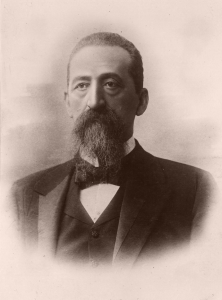Porro, Edoardo

Edoardo Porro (Padua, 1842 – Milan, 1902) graduated in Pavia in 1866 and quickly became assistant at the Major Hospital and at the Obstetrics School of Milan.
In 1875 he was given the chair of Clinical Obstetrics at Pavia University, which he held until 1882 when he returned to Milan to direct Saint Catherine’s Obstetrics School. He developed the “uterus-ovarian caesarean amputation”, which he first performed at the Pavia Clinic on the 21st of May 1876. The operation he devised radically transformed indications and results of the caesarean section as thus performed; up until then, a C-section almost inevitably led to death for the mothers, and sometimes for the foetuses, as well.
Many influences merged into Porro’s procedure. From the extremely skilled experimenter Eusebio Oehl, he derived the idea of testing the amputation on animals before trying it on a pregnant woman; from Zoja, military surgeon and valid teacher of practical and applied anatomy, he learnt the precise anatomical form of the operation. Porro also requested a direct consultation from Mazzucchelli, a surgeon who had become an expert of suppuration processes, and from Edoardo Bassini, who taught Minor Anatomy at Pavia University despite being an outstanding pathologist and developer of surgical procedures.
 Porro’s procedure required the amputation of uterus and ovaries following caesarean section; infection of these organs was in fact, as he had correctly postulated, the cause of maternal death in most of the cases.
Porro’s procedure required the amputation of uterus and ovaries following caesarean section; infection of these organs was in fact, as he had correctly postulated, the cause of maternal death in most of the cases.
There were however some ethical doubts expressed by colleagues, stating that causing sterility in women in such manner was immoral. Porro, ardent Catholic, sought counsel from the bishop of Pavia, monsignor Parocchi, a man of rigid and severe orthodox views; the surgeon was in the end reassured by the religious man’s line of thinking, for he recognised
the right to sacrifice a part in favour of the health of the whole.
After all, Parocchi noted, the practice of castrating young cantors to preserve their white voices was still accepted, even in the Sistine Chapel: he therefore saw no immorality in rendering a woman sterile to save her life.
Porro’s procedure, its meticulous and analytical description and its resounding success caused the new method to become extremely wide spread: many illustrious colleagues adopted Porro’s procedure and thus saved countless lives.
Suggested reading:
Paolo Mazzarello, E si salvò anche la madre: l’evento che rivoluzionò il parto cesareo, Bollati Boringhieri, Torino, 2015.
